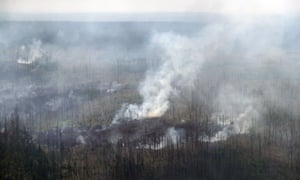Plume from unprecedented blazes forecast to reach Alaska as fires rage for third month
A cloud of smoke and soot bigger than the European Union is billowing across Siberia as wildfires in the Arctic Circle rage into an unprecedented third month.
The normally frozen region, which is a crucial part of the planet’s cooling system, is spewing carbon dioxide into the atmosphere and worsening the manmade climate disruption that created the tinderbox conditions. A spate of huge fires in northern Russia, Alaska, Greenland and Canada discharged 50 megatonnes of CO2 in June and 79 megatonnes in July, far exceeding the previous record for the Arctic.
The
intensity of the blazes continues with 25 megatonnes in the first 11
days of August – extending the duration beyond even the most persistent
fires in the 17-year dataset of Europe’s satellite monitoring system.The normally frozen region, which is a crucial part of the planet’s cooling system, is spewing carbon dioxide into the atmosphere and worsening the manmade climate disruption that created the tinderbox conditions. A spate of huge fires in northern Russia, Alaska, Greenland and Canada discharged 50 megatonnes of CO2 in June and 79 megatonnes in July, far exceeding the previous record for the Arctic.
Mark Parrington, a scientist in the Copernicus Atmosphere Monitoring Service, said the previous record was just a few weeks. “We haven’t seen this before,” he said. “The fire intensity is still well above average.”
He said the affected regions previously registered unusually high temperatures and a low level of soil moisture, which created the perfect conditions for ignition. Globally, June and July were the hottest months ever measured.
Russia has suffered most. Last month, the president, Vladimir Putin, mobilised the army to fight the blazes and four Siberian regions declared a state of emergency. But fires continue to rage. The Earth observation scientist Josef Aschbacher said that in Siberia alone, the two-month inferno had destroyed 4.3m hectares of taiga forest.

The smoke has spread further still. Antti Lipponen, of the Finnish Meteorological Institute, estimates the affected area at 5m square kilometres. “For comparison, the area of EU is about 4.5m km² and the area of contiguous US about 8.1m km²”, he tweeted.
The cloud is billowing north-east and is forecast to reach Alaska, where this year’s fires have already scorched an area bigger than all the wildfires that devastated California last year.
Carly Phillips, of the Union of Concerned Scientists, said Alaskan fires had burned 18.1m acres of forest since 2000, more than double the amount over the previous 20 years.
“Carbon emissions from these wildfires could exacerbate climate warming for decades to come,” she wrote in a blogpost. “Alaska’s ecosystems store huge quantities of carbon both as permafrost and soil that has accumulated over millennia. Wildfires destabilise these stores of carbon by combusting soil and accelerating permafrost thaw, both of which release heat-trapping gases to the atmosphere.”
In Greenland, satellite images this month revealed fires stretching across an area 380km wide, adding to the pressures of an Arctic heatwave that caused a record melt-off of the world’s second biggest ice sheet. This week, a huge wildfire in the Qeqqata region left a smouldering area of 6.9km².
Since the start of the year, more than 13.1m hectares have burned, according to Greenpeace, which says this has released as much carbon dioxide as a year’s worth of exhaust fumes from 36m cars.
The Arctic is not the only afflicted region. So far this year, the EU has had 1,600 fires bigger than 30 hectares, which is four times the annual average over the previous decade, according to the Copernicus Atmosphere Monitoring Service.
About 1,000 holidaymakers had to evacuate resorts in Gran Canaria this week to escape wildfires. Last month, campers had to abandon their tents due to a fast-spreading blaze in southern France during a heatwave.
In the UK, the Fire Brigades Union says there have been 10% more callouts this year, which has overstretched emergency resources. Firefighter numbers had fallen by a fifth since 2010 due to government cuts, the union said.

No comments:
Post a Comment